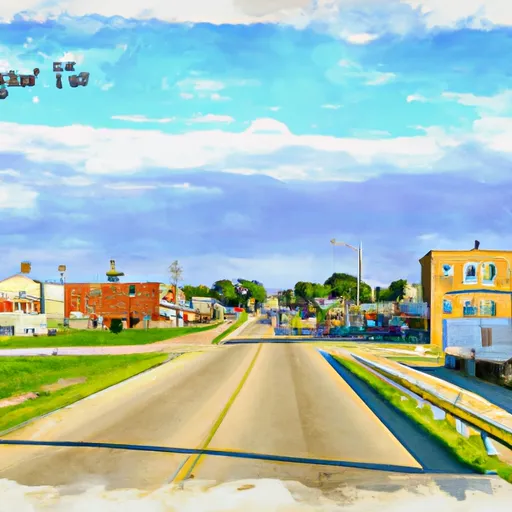-
 Snoflo Premium
Snoflo Premium
Get unlimited access to all our content
With no Ad interruptions! - Start Your Free Trial Login with existing account
Talmage
Eden Index
Climate
8.1
•
Recreation
3.1
•
Community
•
Safeguard
4.3/10

Talmage, Nebraska is a small village located in Otoe County, situated in the southeastern part of the state. The climate in Talmage is characterized by four distinct seasons. Summers are generally warm and humid, with temperatures ranging from the 70s°F to the 90s°F. Winters tend to be cold, with temperatures dropping below freezing, and occasional snowfall. Spring and autumn offer mild temperatures, making them pleasant seasons to explore the outdoors.
In terms of hydrology constituents, Talmage rests near the banks of the Little Nemaha River, which provides a water source for the area. Additionally, there are several small creeks and streams that run through the village, contributing to the local hydrological landscape.
Outdoor recreation opportunities in Talmage are abundant. The village is surrounded by picturesque countryside, making it an ideal location for activities such as hiking, biking, and picnicking. Talmage Park is a popular spot for locals and visitors alike, offering amenities such as playgrounds, picnic areas, and sports fields. Moreover, the nearby Little Nemaha River provides opportunities for fishing and canoeing. Overall, Talmage provides a serene environment for outdoor enthusiasts to enjoy nature's beauty.
What is the Eden Index?
The Snoflo Eden Index serves as a comprehensive rating system for regions, evaluating their desirability through a holistic assessment of climate health, outdoor recreation opportunities, and natural disaster risk, acknowledging the profound impact of these factors on livability and well-being.
Climate Health Indicator (CHI): 8.1
Talmage receives approximately
806mm of rain per year,
with humidity levels near 83%
and air temperatures averaging around
11°C.
Talmage has a plant hardyness factor of
5, meaning
plants and agriculture in this region thrive during a short period during spring and early summer. Most
plants will die off during the colder winter months.
By considering the ideal temperature range, reliable water supplies, clean air, and stable seasonal rain or snowpacks, the Climate Health Indicator (CHI) underscores the significance of a healthy climate as the foundation for quality living.
A healthy climate is paramount for ensuring a high quality of life and livability in a region, fostering both physical well-being and environmental harmony. This can be characterized by ideal temperatures, reliable access to water supplies, clean air, and consistent seasonal rain or snowpacks.
Weather Forecast
Streamflow Conditions
Missouri-Nishnabotna
Area Rivers
Missouri-Nishnabotna
Snowpack Depths
Missouri-Nishnabotna
Reservoir Storage Capacity
Missouri-Nishnabotna
Groundwater Levels
Recreational Opportunity Index (ROI): 3.1
The Recreational Opportunity Index (ROI) recognizes the value of outdoor recreational options, such as parks, hiking trails, camping sites, and fishing spots, while acknowledging that climate plays a pivotal role in ensuring the comfort and consistency of these experiences.
Access to outdoor recreational opportunities, encompassing activities such as parks, hiking, camping, and fishing, is crucial for overall well-being, and the climate plays a pivotal role in enabling and enhancing these experiences, ensuring that individuals can engage in nature-based activities comfortably and consistently.
Camping Areas
| Campground | Campsites | Reservations | Toilets | Showers | Elevation |
|---|---|---|---|---|---|
| St Marys Riverside Park | None | 944 ft | |||
| Humboldt Lake Park | 12 | 982 ft | |||
| Sun Dance - Melvern Lake | None | 1,079 ft | |||
| Louisville Lakes State Rec Area | 300 | 1,032 ft | |||
| Riverview Marina State Rec Area | 46 | 1,021 ft | |||
| Weeping Water | 25 | 1,081 ft | |||
| Centralia Lake | None | 1,285 ft | |||
| Iron Horse Trail Lake | 11 | 1,132 ft | |||
| Offutt AFB Military | None | 963 ft | |||
| Sabetha Lake | None | 1,241 ft |
Nearby Ski Areas
Catastrophe Safeguard Index (CSI):
The Catastrophe Safeguard Index (CSI) recognizes that natural disaster risk, encompassing floods, fires, hurricanes, and tornadoes, can drastically affect safety and the overall appeal of an area.
The level of natural disaster risk in a region significantly affects safety and the overall livability, with climate change amplifying these risks by potentially increasing the frequency and intensity of events like floods, fires, hurricanes, and tornadoes, thereby posing substantial challenges to community resilience and well-being.
Community Resilience Indicator (CRI):
The Community Resilience Indicator (CRI) recognizes that education, healthcare, and socioeconomics are crucial to the well-being of a region. The CRI acknowledges the profound impact of these elements on residents' overall quality of life. By evaluating educational resources, healthcare accessibility, and economic inclusivity, the index captures the essential aspects that contribute to a thriving community, fostering resident satisfaction, equity, and social cohesion.

